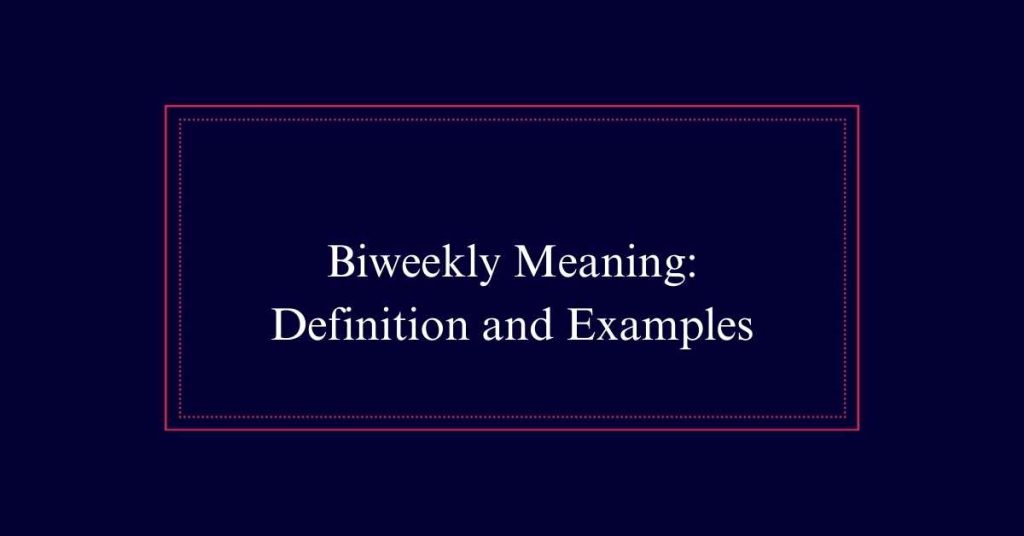Biweekly Meaning: Definition and Examples
The term ‘biweekly’ can mean either twice a week or once every two weeks, leading to potential confusion. Originating from the Latin word ‘bis,’ meaning twice, the term has been in use since the 15th century. Its meaning varies by context, often used in professional settings for meeting schedules or pay periods. For clarity, specifying exact dates or frequency is important. In British English, ‘fortnight’ is an alternative term for once every two weeks.
Definition of Biweekly
The term ‘biweekly’ refers to events occurring either twice a week or once every two weeks. This dual definition can cause confusion. The prefix ‘bi-‘ means both ‘two’ and ‘twice,’ leading to ambiguity.
In professional settings, ‘biweekly’ is often used to describe meeting schedules or pay frequencies. For example, biweekly pay means receiving paychecks once every two weeks. It is important to clarify the intended meaning when using the term.
British English offers an alternative term, ‘fortnight,’ which specifically means once every two weeks. Understanding these nuances guarantees clear communication, whether referring to publishing schedules, payroll, or other recurring events.

Origins of the Term
Biweekly has its roots in the Latin word ‘bis,’ meaning ‘twice.’ This prefix ‘bi-‘ combines with ‘weekly’ to form ‘biweekly.’ The term has been in use since the 15th century.
Initially, it was used to describe events that occur twice within a single week. Over time, the meaning expanded to include events that happen once every two weeks.
The dual definitions have led to some confusion. However, both usages are widely accepted in modern English.
The word ‘biweekly’ reflects the flexible nature of language, adapting to different contexts and needs. Understanding its origins helps clarify its dual meanings and their historical development.
Common Misconceptions
Many people mistakenly believe ‘biweekly’ only means once every two weeks. However, ‘biweekly’ can also mean twice a week. This dual meaning often causes confusion.
| Frequency | Common Example | Clarification |
|---|---|---|
| Twice a week | Biweekly meetings | Meetings happen every few days. |
| Once every two weeks | Biweekly paychecks | Paychecks are issued every other week. |
| Twice a month | Biweekly newsletters | Newsletters sent two times monthly. |
| Every other week | Biweekly therapy | Sessions occur biweekly (fortnightly). |
| Twice weekly | Biweekly workouts | Workouts happen twice a week. |
Usage in Professional Settings
In professional settings, ‘biweekly’ often describes the frequency of meetings or pay periods. This term is essential for maintaining effective communication and scheduling within organizations. Understanding the exact meaning of ‘biweekly’ can prevent confusion and promote smooth operations.
It is commonly used to:
- Schedule recurring meetings, guaranteeing regular updates and progress checks.
- Define pay periods, clarifying when employees can expect their wages.
- Plan project milestones, providing a structured timeline for task completion.
Using ‘biweekly’ correctly in these contexts helps foster clear expectations and efficient workflow. Clarity in communication is key to professional success, and knowing the specific meaning of ‘biweekly’ contributes to this clarity in professional environments.
Biweekly Pay Explained
Understanding the frequency of pay periods is important for financial planning, making it necessary to clarify what ‘biweekly pay’ entails. Biweekly pay means employees receive their wages every two weeks. This results in 26 paychecks per year. Each paycheck covers a two-week work period.
For example, if a company issues paychecks every other Friday, that is a biweekly pay schedule. This payment method is beneficial for budgeting, as it provides consistent and predictable income. Employees can plan their expenses more effectively.
It’s also different from semi-monthly pay, where employees are paid twice a month, resulting in 24 paychecks per year. Understanding these differences is essential for accurate financial management.
Publication Schedules
Publication schedules play an essential role in determining the frequency and timing of content releases. They guarantee that content is delivered consistently, meeting audience expectations.
When a publication is described as ‘biweekly,’ it can cause confusion due to its dual meaning. Therefore, clarity is important.
- Twice a week: Some magazines or newsletters publish twice weekly, providing frequent updates.
- Every two weeks: Others, like certain journals, opt for a biweekly schedule, releasing content every other week.
- Consistency: Regular schedules build trust and keep the audience engaged.
Other Time-Related Prefixes
Time-related prefixes like ‘bimonthly,’ ‘biannual,’ and ‘biennial’ often create confusion. For instance, ‘bimonthly’ can mean either twice a month or once every two months. Similarly, ‘biannual’ means twice a year, while ‘biennial’ means once every two years.
These prefixes can lead to misunderstandings if the context is not clear. Workplace schedules, publication dates, and event planning can all be affected by these ambiguities.
To avoid confusion, it is important to specify the exact intervals. Using terms like ‘every two weeks’ or ‘twice a month’ can provide clarity and make sure that everyone is on the same page.
Examples in Sentences
Using ‘biweekly’ in sentences can provide clarity on how this term applies in real-world scenarios. Here are some practical examples:
- Employees receive biweekly paychecks, meaning they are paid every two weeks.
- The team holds biweekly meetings to guarantee consistent updates on project progress.
- A biweekly newsletter keeps subscribers informed with less frequent but richer content.
These examples illustrate how ‘biweekly’ can describe various schedules and routines.
Whether in professional or personal settings, understanding the context is key.
For instance, if a company states that reviews are biweekly, employees should prepare for evaluations every other week.
Biweekly Vs. Fortnight
Many people wonder about the difference between ‘biweekly’ and ‘fortnight.’ ‘Biweekly’ can mean either twice a week or once every two weeks, which often leads to confusion.
In contrast, ‘fortnight’ is a term used primarily in British English and always means a period of two weeks.
When someone says they have a biweekly meeting, it might be unclear if it occurs twice a week or every two weeks. However, if they say they have a fortnightly meeting, it is clear that it happens every two weeks.
Understanding these terms can help avoid miscommunication in planning schedules and events. Using ‘fortnight’ can be more specific and eliminate ambiguity.
Clarifying Biweekly Frequency
To clarify the frequency of ‘biweekly,’ it is essential to specify whether it means twice a week or every two weeks. Misunderstandings can arise due to the dual meanings of the prefix ‘bi-.’
For clear communication, always define the intended frequency.
Here are some tips to avoid confusion:
- Specify the exact days or dates. For example, ‘meetings every Monday and Thursday’ or ‘meetings every other Monday.’
- Use alternative terms like ‘semi-weekly’ for twice a week and ‘fortnightly’ for every two weeks in British English.
- Contextualize the usage based on common practices in your field, such as payroll cycles or publication schedules.
Frequently Asked Questions
Can ‘Biweekly’ Refer to Events Occurring Twice in One Day?
No, ‘biweekly’ cannot refer to events occurring twice in one day. It specifically refers to occurrences either twice a week or once every two weeks, depending on the context in which it is used.
How Is ‘Biweekly’ Different From ‘Semimonthly’?
‘Biweekly’ means occurring every two weeks, while ‘semimonthly’ means occurring twice a month. The key difference is that ‘biweekly’ events happen every other week, whereas ‘semimonthly’ events occur roughly every fifteen days.
Is ‘Biweekly’ Usage Common in Informal Conversations?
‘Biweekly’ is less common in informal conversations due to its ambiguity. People often prefer clearer terms like “every other week” to avoid confusion. However, it is frequently used in professional and formal settings.







